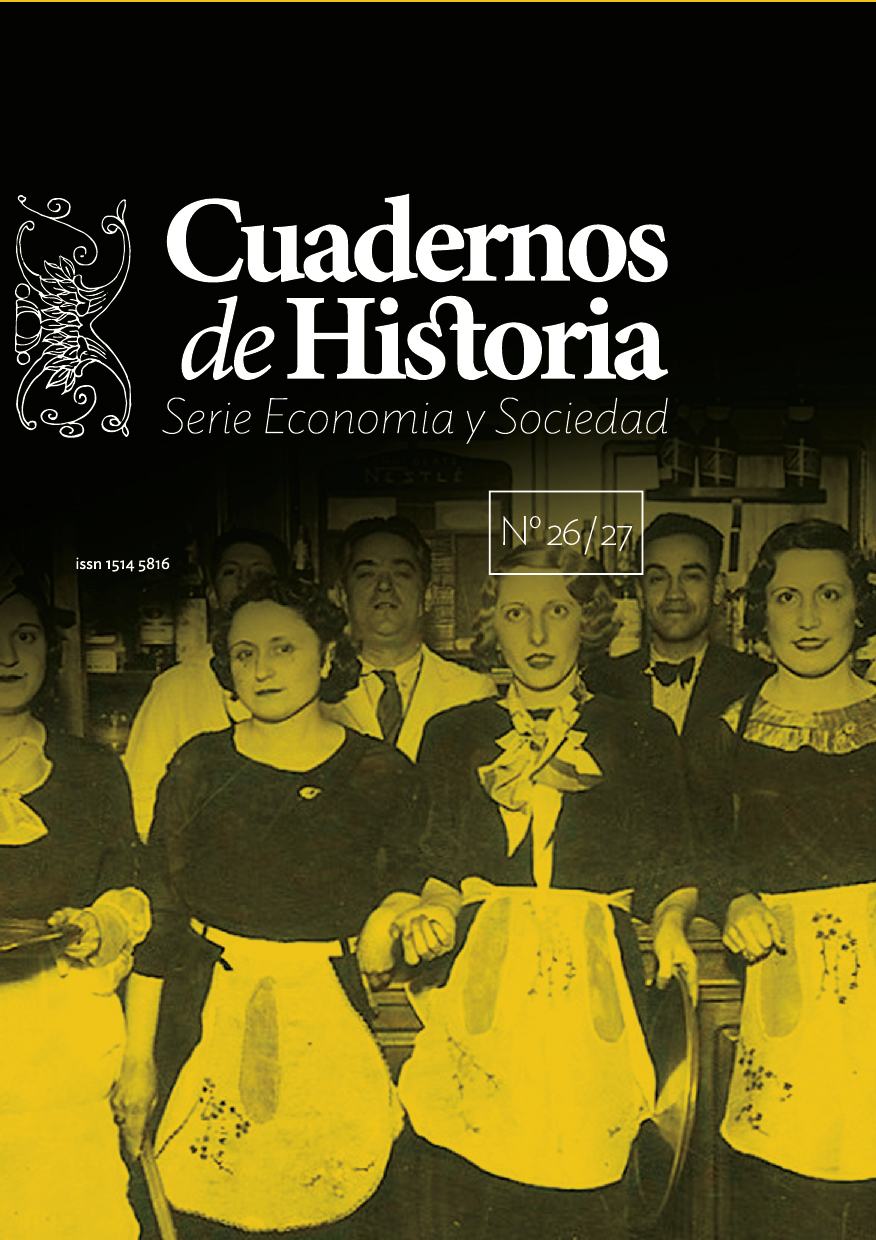Indigenous lands and military services in the southern frontier of Cuyo, 17th-19th centuries
DOI:
https://doi.org/10.53872/2422.7544.n26/27.33551Keywords:
Huarpes’s and puelches’s lands, Military services, Mapuche frontierAbstract
This work analyzes how the indigenous people of the center of Cuyo obtained recognition of lands and leadership in Corocorto and the Guanacache lagoons from the late seventeenth to the early nineteenth centuries. The hypothesis is that the need of the Spaniards to protect the Mapuche border opened a space to obtain these rights for the early colonized Indians within the territory of colonial rule in exchange for their defensive military presence and military services on the border.
References
Amselle, J. L. 1998, Mestizo Logics. Anthropology of identity in Africa and Elsewhere, Stanford University Press.
Barth, F. 1976, Los grupos étnicos y sus fronteras, Fondo de Cultura Económica, México.
Boccara, G. 2007, Los vencedores: Historia del pueblo mapuche en la época colonial, Universidad Católica del Norte, San Pedro de Atacama.
Canals Frau, S. 1946, “Etnología de los huarpes. Una síntesis” en Anales del Instituto de Etnología Americana, 7, pp. 9 a 149.
Cueto, A. O. 1989, “La legislación hispánica sobre tierras y su vigencia en la Mendoza colonial (siglos XVI-XIX)” en Revista de Estudios Regionales, 3, pp. 65 a 108.
Escolar, D. 2007, Los Dones étnicos de la Nación. Identidades huarpes y modos de producción de soberanía en Argentina, Prometeo, Buenos Aires.
Escolar, D. 2020a, “Mitologías soberanas: tierras indígenas y construcción de la propiedad privada en Mendoza a fines del siglo XIX” en Memoria Americana. Cuadernos de Etnohistoria, 28, 1, pp. 92 a 116.
Escolar, D. 2020b, “Los ‘últimos caciques’ de Cuyo. Tierras, política y memorias indígenas en la Argentina criolla (Mogna, siglos XVII-XIX)” en Revista del Museo de Antropología 13, 2, pp. 215 a 230.
Jara, A. 1958, “Importación de trabajadores indígenas en el siglo XVII” en Revista Chilena de Historia y Geografía, 124, pp. 175 a 212.
Michieli, C. T. 2000, La disolución de la categoría jurídico-social de «indio» en el siglo XVIII: El caso de San Juan (Región de Cuyo), Universidad Nacional de San Juan/ Facultad de Filosofía Humanidades y Artes/ Instituto de Investigaciones Arqueológicas y Museo, San Juan.
Michieli, C. T. 1992, “Tráfico transcordillerano de ganado y la acción de los indígenas cuyanos en el siglo XVII” en Publicaciones del Instituto de Investigaciones Arqueológicas y Museo UNSJ, 19, pp. 21 a 47.
Morales Guiñazú, F. 1938, Primitivos Habitantes de Mendoza (Huarpes, Puelches, Pehuenches, Aucas, su lucha, su desaparición), Best Hermanos, Mendoza.
Nacuzzi, L. R. 1998, Identidades impuestas: tehuelches, aucas y pampas en el norte de la Patagonia. Sociedad Argentina de Antropología, Buenos Aires.
Prieto, M. de R. 2000, “Formación y consolidación de una sociedad de frontera en un área marginal del Reino de Chile: La provincia de Cuyo en el siglo XVII” en Anales de Arqueología y Etnología, 52-53.
Prieto, M. del R. 1976, “El proceso de aculturación de los huarpes de Mendoza” en Anales de Arqueología y Etnología XXIX-XXXI, , pp. 237 a 272.
Sosa Morales, N. 1965, El muy magnífico señor Don José Francisco de Amigorena (Cuyo durante la intendencia de Córdoba), s.e.
Torre Revelo, J. 1946, El Marqués de Sobremonte, Gobernador intendente de Córdoba y Virrey del Río de la Plata. Ensayo Histórico. Publicaciones del Instituto de Investigaciones Históricas, Facultad de Filosofías y Letras, Buenos Aires.
Verdaguer, J. A. 1931, Historia eclesiástica de Cuyo (I), Premiata Scuola Tipográfica Salesiana, Milano.
Downloads
Published
Issue
Section
License
Copyright (c) 2021 Cuadernos de Historia. Serie Economía y Sociedad

This work is licensed under a Creative Commons Attribution 4.0 International License.
Authors publishing in this journal accept the following terms:
a. The author maintains their copyrights and grants this journal the publication of the first original version of their work that is subject to the Creative Commons Attribution License 4.0. This license agreement allows:
Sharing — copy and redistribution of the published material by any means and formats
Reusing — remix, change, and creation of new material from the published work for any purpose, including commercial use.
b. Authors may enter other non-exclusive license agreements of distribution of the version of the published work (i.e. uploading the material on an institutional virtual archive or republishing it on a monographic volume) as long as they attribute the publication of the original version to this journal.
c. It is allowed and recommended that authors publicize their work on the Internet (i.e. on institutional virtual archives or on their personal or professional websites) after their work has been published in this journal.




